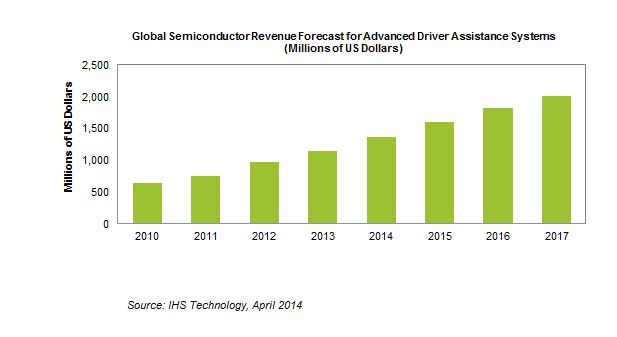El Segundo, Calif. (April 28, 2014)—Powered by increasing demand for car- and driver-augmented safety features, the global semiconductor market for advanced driver assistance systems (ADAS) will quadruple over a one-decade period, according to a new report from IHS Technology (NYSE: IHS).

Worldwide revenue for ADAS chips is projected to reach $2.6 billion in 2020, more than fourfold the size of the market of $643.8 million a decade earlier in 2010. The first eight years of this 10-year period will see ADAS global revenue grow by strong double-digit percentages, with the last two years of the forecast window slightly moderating to still-impressive 9 percent increases.
This year alone, growth is expected to reach 20 percent, even higher than last year’s 18 percent. Revenue will break the $2 billion mark for the first time by 2017, as shown in the attached figure. And with autonomous vehicles expected to further stoke the market, ADAS will continue to generate high growth rates even into the next decade from 2020 to 2030.
“IHS expects ADAS content in cars to grow steadily for many years, owing to an increasing number of features that will be implemented in the car, with an aim toward deploying increasingly autonomous vehicles,” said Luca DeAmbroggi, principal analyst for automotive demand at IHS. “The market will also be helped by the implementation of data-fusion modules—extra hardware added to combine the input coming from two or more different sensors present in the car— because of the need for more sensing redundancy and for higher functional-safety requirements in vehicles.”
ADAS are systems designed to help drivers maneuver their cars more safely. ADAS achieves this through various means—including providing alerts that notify a driver when something is amiss, or by equipping a car to operate more securely through built-in safety features. In all instances, sensitive semiconductors are paramount for attaining efficient ADAS.
In adaptive cruise control, for instance, the system automatically adjusts vehicle speed to keep cars a safe distance away from vehicles ahead. Lane-departure warning notifies a driver when a car starts to swerve from its own lane if the turn signals are not being used, while blind-spot detection sends an alert when drivers switch lanes and enter the dangerous blind-spot zone without visibility that could cause collisions.
Other ADAS examples include automatic parking to help align cars in parallel parking; night vision to increase a driver’s seeing distance in darkness or bad weather; and driver-drowsiness detection to help prevent accidents when the car detects a driving pattern deviating from normal patterns.
One particular bright spot in ADAS revenue is the front-view camera, with customer demand and safety regulations acting as the major drivers, said Akhilesh Kona, analyst for automotive semiconductors at IHS. Here, image sensors in the camera systems can analyze video content for vehicular functions such as lane-keeping assistance, lane-departure warning, traffic-sign recognition and high/low-beam headlight control.
Other applications generating tremendous interest are based on radar and LiDAR— the last a portmanteau of the words “light” and “radar.” Both radar and LiDAR use remote-sensing technology to help determine any number of variables in which the vehicle is encountering, such as road conditions, objects surrounding the vehicle, or the speed of other nearby cars.
Revenue for semiconductors used in both front-camera and LiDAR modules is forecast to grow steadily, Kona noted. “For the front-camera chip market, total takings will reach $650 million in 2020, up from $118 million last year,” he said. Meanwhile, revenue for the radar and LiDAR chip space will amount to $653 million in 2020, compared to $236 million in 2013, equivalent to a compound annual growth rate of 16 percent, Kona added. .
Additional ADAS mechanisms could be present in the future to monitor both drivers and passengers within a car. Applications like a road-frustration index could help increase the safety quotient for autonomous driving—not only making the driving experience more enjoyable as a whole, but also helping prevent accidents on the road, IHS believes.
Advertisement
Learn more about IHS iSuppli





